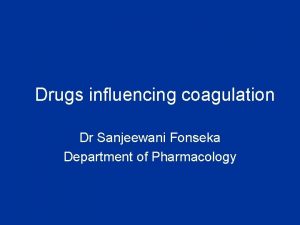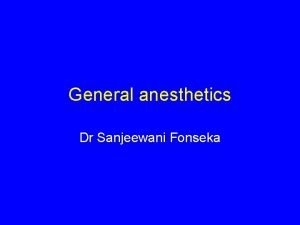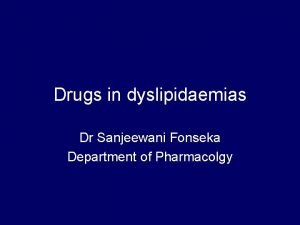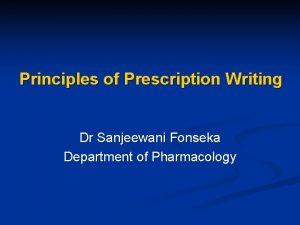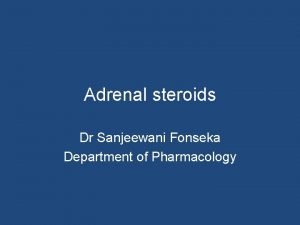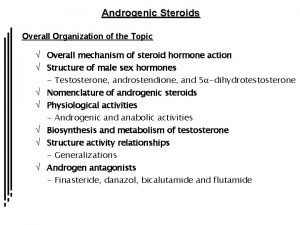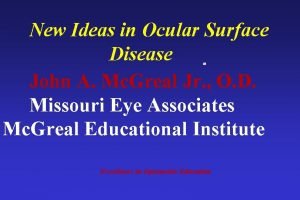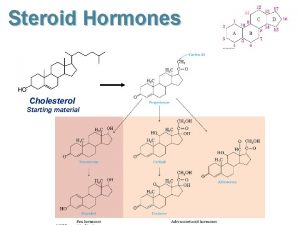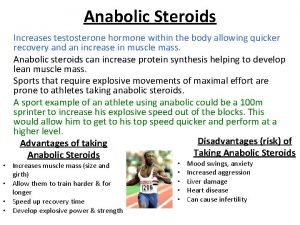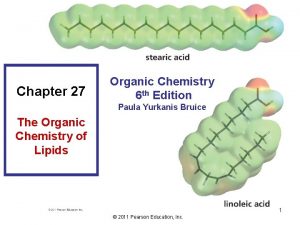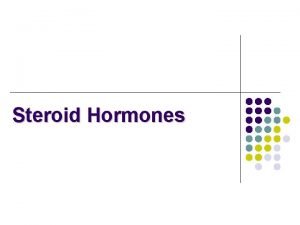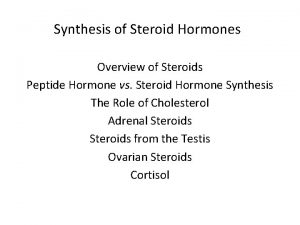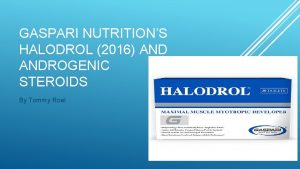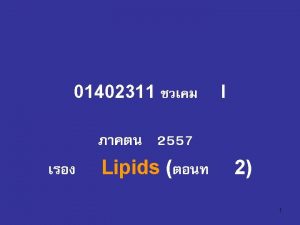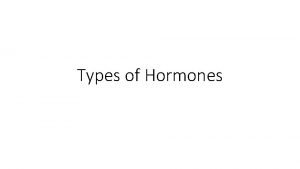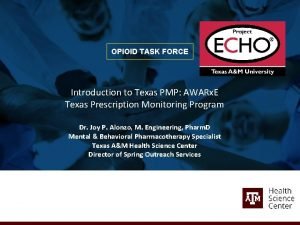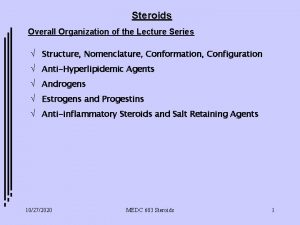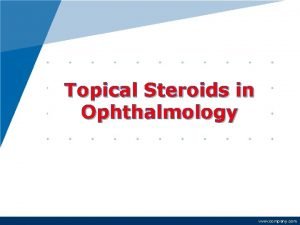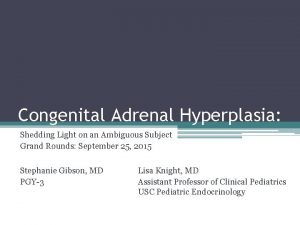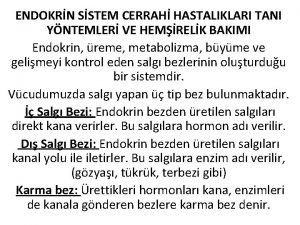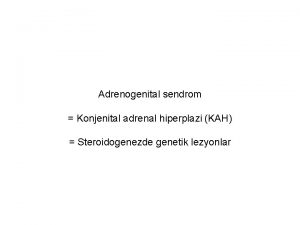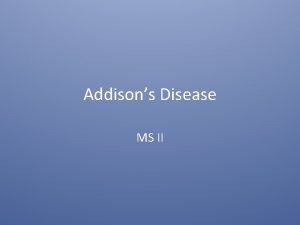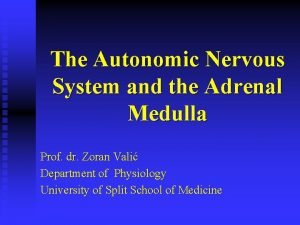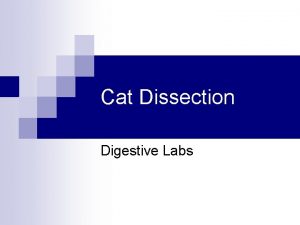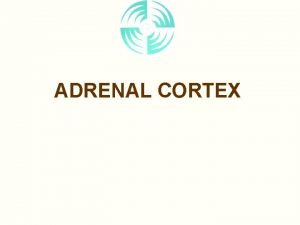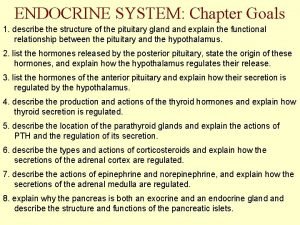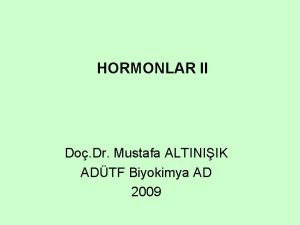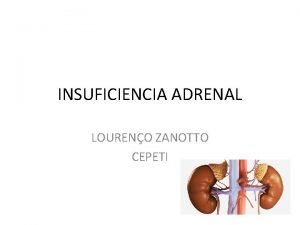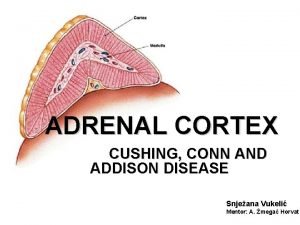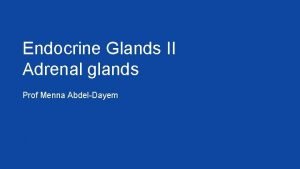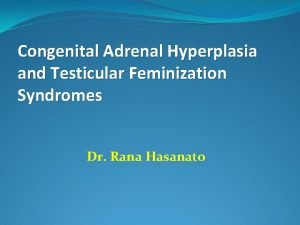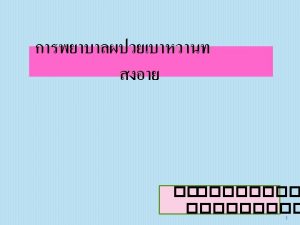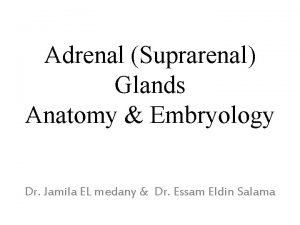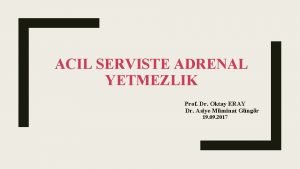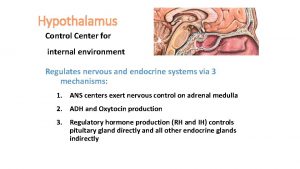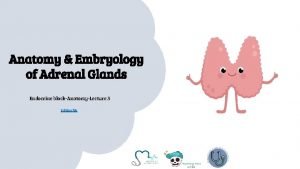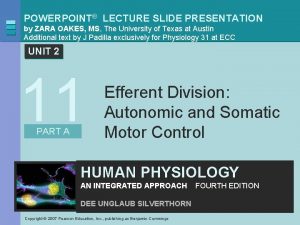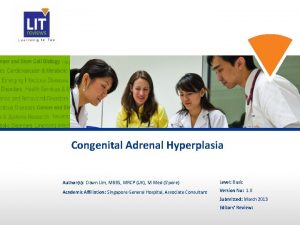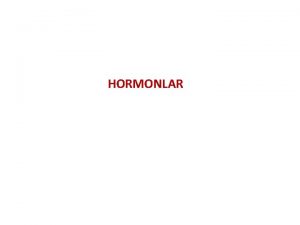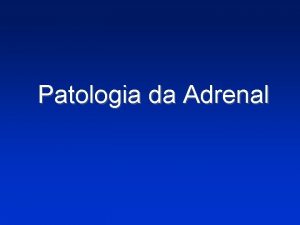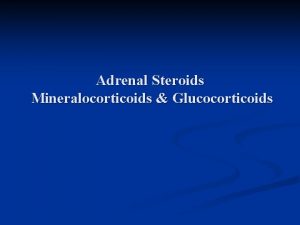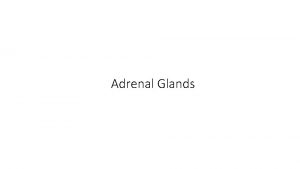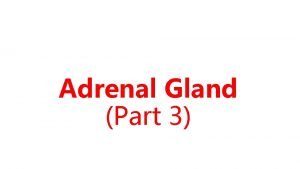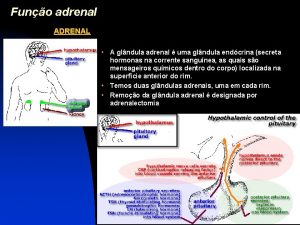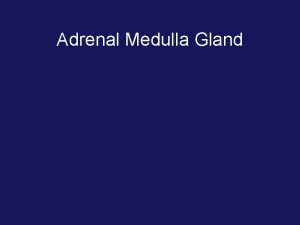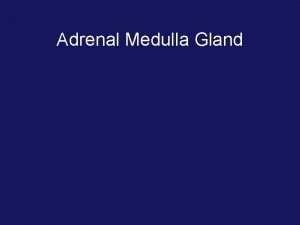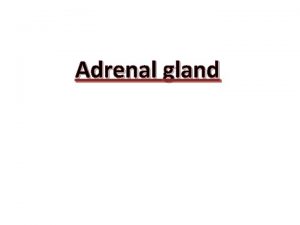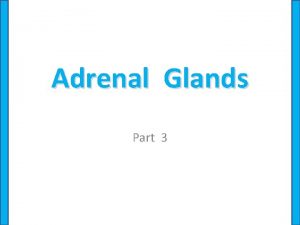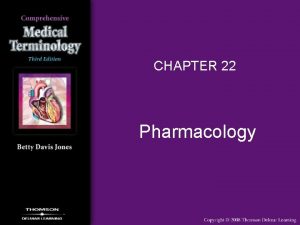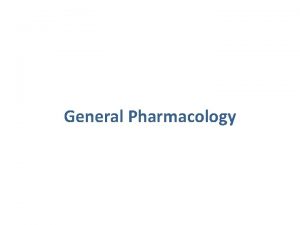Adrenal steroids Dr Sanjeewani Fonseka Department of Pharmacology















































- Slides: 47

Adrenal steroids Dr Sanjeewani Fonseka Department of Pharmacology

Objectives • Recall the physiological effect of adrenocortical steroids • Describe the anti- inflammatory and immunosuppressive effects of glucocorticoids • Compare the relative potency, glucocorticoid/mineralocorticoid activity and duration of action of commonly available steroid drugs • List clinical uses and adverse effects of glucocorticoid drugs • Explain the principles underling replacement therapy in adrenocortical insufficiency • Describe the precautions that can be taken to minimize the adverse effects of long-term steroid therapy



Endogenous Glucocorticoids Hydrocortisone Corticosterone


Corticosteroids are Gene-Active



Glucocorticoids Kinetics: • Well absorbed orally • Bound to corticosteroid-binding globulin and albumin • Distributed all over the body & passes the BBB • In the liver, cortisol is reversibly converted to cortisone & conjugated with glucuronic & sulfuric acid • Excreted in urine as 17 -hydroxy corticosteroids

Action of glucocorticoids • Metabolic • Anti-inflammatory • Immunosuppressive

Actions 1. Carbohydrate 8. Stomach 2. Protein 9. Blood 3. Lipid 10. Anti-inflammatory 4. Electrolyte and H 2 O 11. Immunosuppressant 5. CVS 12. Growth and Cell Division 6. Skeletal Muscle 13. Calcium metabolism 7. CNS

Carbohydrate metabolism • Gluconeogenesis – Peripheral actions (mobilize – Hepatic actions glucose and glycogen) • Peripheral utilization of glucose • Glycogen deposition in liver (activation of hepatic glycogen synthase) hyperglycemia

protein metabolism Negative nitrogen balance • Decreased protein synthesis • Increased protein breakdown

Skeletal Muscles Needed for maintaining the normal function of Skeletal muscle Addison's disease: weakness and fatigue is due to inadequacy of circulatory system Prolonged use: Steroid myopathy

Lipid metabolism • Redistribution of Fat

Electrolyte and water balance Act on DT and CD of kidney – Na+ reabsorption – Urinary excretion of K+ and H+

CNS • Direct – Mood – Behavior – Brain excitability • Indirect – maintain glucose, circulation and electrolyte balance

Stomach – Acid and pepsin secretion – immune response to H. Pylori

Blood RBC: Hb and RBC content (erythrophagocytosis) WBC: Lymphocytes, eosinophils, monocytes, basophils Polymorphonucleocytes

Actions on inflammatory cells • Recruitment of N, monocytes, macrophage into affected area • Action of fibroblasts • T helper action • Osteoblast • osteoclast

Inflammatory mediators • Reduced cytokines • Reduced complement • Reduced histamine

Anti-inflammatory actions of corticosteroids Corticosteroid inhibitory effect

Growth and Cell division • Inhibit cell division or synthesis of DNA • Delay the process of healing • Retard the growth of children

Calcium metabolism • Intestinal absorption • Renal excretion • Excessive loss of calcium from bones (e. g. , vertebrae, ribs, etc) • Osteoporosis

Pharmacological Actions • synthetic glucocorticoids are used because they have a higher affinity for the receptor • have little or no salt-retaining properties.

Clinical uses • Replacement therapy • Immunosuppressive / anti-inflammatory therapy • Neoplastic disease

Types of Steroids Replacement Therapy • glucocorticoid (hydrocortisone) • mineralocorticoid (fludrocortisone)

Anti-inflammatory Therapy • Short acting: hydrocortisone • Intermediate acting: prednisolone, methylprednisolone, triamcinolone • Long acting: dexamethasone

Preparations Drug Cortisol Anti-inflam. Salt retaining Topical 1 1. 0 1 0. 8 0 Prednisone 4 0. 8 0 Prednisolone 5 0. 3 4 Methylprednisolone 5 0 5 Paramethasone 10 0 - Fluprednisolone 15 0 7 Cortisone Intermediate acting Triamcinolone

Preparations Drug Anti-inflam. Salt retaining Topical Long acting Betamethasone 25 -40 Dexamethasone 30 Mineralocorticoids Fludrocortisone 10 DOCA 0 0 0 10 10 250 20 10 0

Side effects • Not seen in replacement therapy • Seen if used for anti-inflammatory property • Excess of physiological actions

Iatrogenic Cushing’s syndrome

Adverse effects (long term) • • • Glucose intolerance Acne Hypertension, edema Susceptibility to infection (TB, fungal) Myopathy Behavior & mood changes




Adverse effects (long term) • • • Avascular necrosis of bone Cataract Peptic ulcer Skin atrophy, delayed wound healing Growth retardation (children) Suppression of HPA axis


Drug interactions • Estrogens - decrease prednisone clearance • Phenobarbital, phenytoin, and rifampicin increase metabolism of glucocorticoids • May cause digitalis toxicity secondary to hypokalemia • Monitor for hypokalemia with co-administration of diuretics

Read Monitoring while on steroids Pregnancy and steroids Infections and long term steroid Surgery and steroids

Summary


long term steroids • Monitor BP, electrolyte and blood sugar • Advise moderate exercise • Bone protection measures • Gastric protection if needed

• Give morning dose • Every other day • Minimum effective dose • Steroid sparing agents


Read • Mineralocorticoids – action, side effects, clinical uses
 Sanjeewani fonseka
Sanjeewani fonseka Dr sanjeewani fonseka
Dr sanjeewani fonseka Dr sanjeewani fonseka channeling
Dr sanjeewani fonseka channeling Dr sanjeewani fonseka
Dr sanjeewani fonseka Principles of prescription
Principles of prescription Dr.sanjeewani fonseka
Dr.sanjeewani fonseka Adrenal drugs pharmacology
Adrenal drugs pharmacology 17a methyl 1 testosterone
17a methyl 1 testosterone Restasis cost
Restasis cost Steroids and cholesterol
Steroids and cholesterol Phospholipids
Phospholipids Anabolic rx24 composition
Anabolic rx24 composition Terpenes steroids prostaglandins
Terpenes steroids prostaglandins Classes of hormones
Classes of hormones Steroid medicine list
Steroid medicine list Gaspari halodrol
Gaspari halodrol Steroid
Steroid Steroid
Steroid Adelphi research steroids
Adelphi research steroids Gonads glands
Gonads glands Pmp steroids
Pmp steroids Picture of steroids
Picture of steroids Steroids meaning
Steroids meaning Non classical adrenal hyperplasia
Non classical adrenal hyperplasia Adrenal bezin hipofonksiyonu sonucu gelişen tablo
Adrenal bezin hipofonksiyonu sonucu gelişen tablo Konjenital lipoid adrenal hiperplazi
Konjenital lipoid adrenal hiperplazi Adrenal insufficency
Adrenal insufficency Hipotiroidismo congénito primario
Hipotiroidismo congénito primario The adrenal medullae secrete
The adrenal medullae secrete Biscuspid valve
Biscuspid valve Adrenal medulla cortex
Adrenal medulla cortex Schlussel urology
Schlussel urology Summary of adrenal gland
Summary of adrenal gland Kolekalsiferol
Kolekalsiferol Arritimias
Arritimias Conn cushing addison
Conn cushing addison Adrenal gland regions
Adrenal gland regions Site:slidetodoc.com
Site:slidetodoc.com Nursing diagnosis of adrenal tumor
Nursing diagnosis of adrenal tumor Nerve supply of adrenal gland
Nerve supply of adrenal gland Adrenal yetmezlik acilci
Adrenal yetmezlik acilci Hypothalamus
Hypothalamus Betoderm
Betoderm Aydede yüz
Aydede yüz Adrenal sympathetic pathway
Adrenal sympathetic pathway Pencreas
Pencreas Non classical adrenal hyperplasia
Non classical adrenal hyperplasia Pankreas hormonları
Pankreas hormonları

